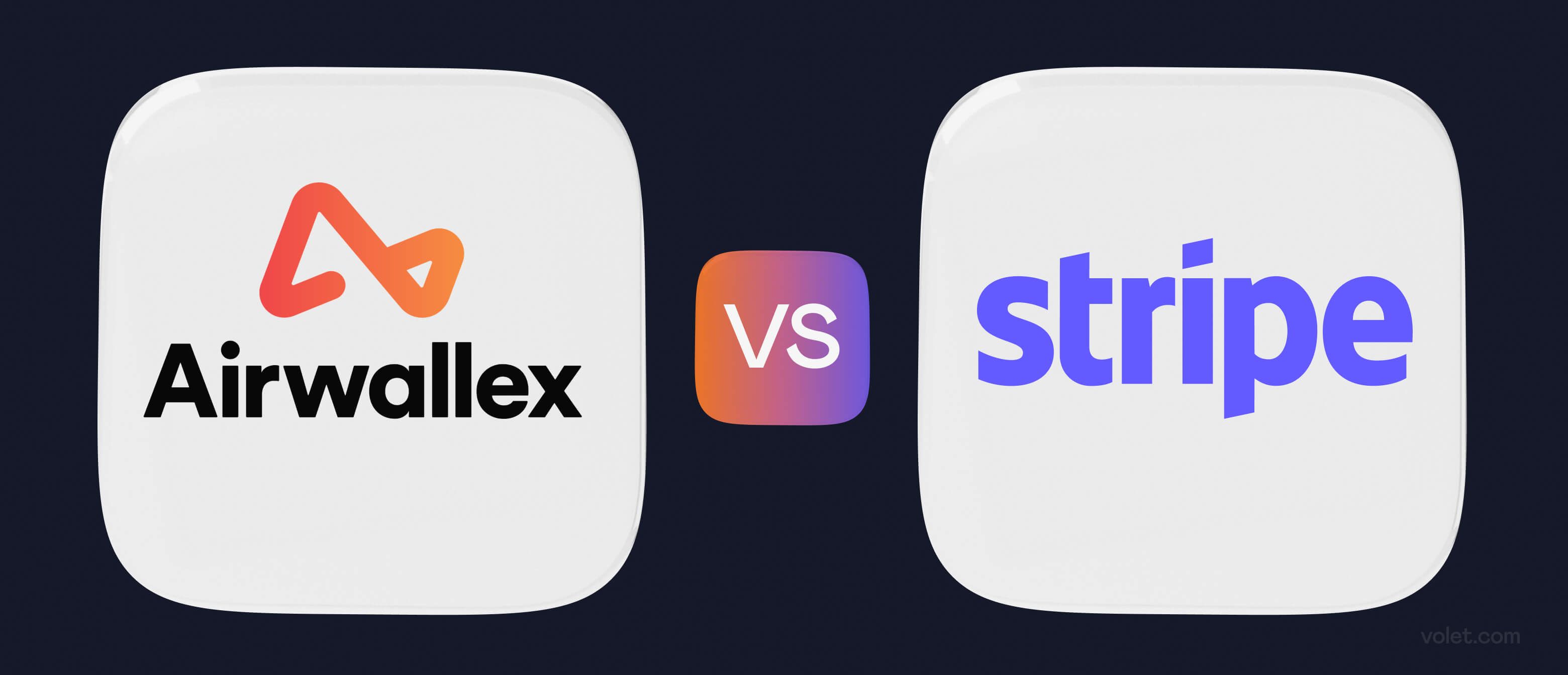 13 min
13 min 739
739Airwallex vs Stripe: Which Payment Processor Is Right for Your Business?
The 2025 Verdict: When to Choose Airwallex's Multi-Currency Accounts Over Stripe APIs

TL;DR: Stripe (3.5% + $0.30) suits tech-savvy businesses with its polished APIs, but frozen accounts and poor support might become an issue. Airwallex (3.4% + $0.30) shines for SMBs with cheaper FX and multi-currency accounts, though its mobile app lacks alerts. Pick Stripe for subscriptions, Airwallex for global payments.
You’ve probably compared Stripe and Airwallex multiple times. At first glance, both platforms handle global payments very smoothly—but depending on the context you’re operating your business in, one might serve you much better than the other.
If you ask me, having spent days researching this, I’d say Airwallex offers a developer experience nearly identical to Stripe’s, with slightly lower fees: 3.4% + $0.30 per international card transaction, versus Stripe’s 3.5% + $0.30. And the only major difference is the difficulty with the setup when it comes to Stripe, notwithstanding of course the fact that Airwallex will not serve individuals. However, there are nuances you might be interested in. For example, users on sites like TrustPilot and G2 note a drawback — Airwallex’s mobile app doesn’t send real-time payment notifications. Stripe, meanwhile, tends to deliver a more polished experience overall.
In this guide, I’ve done the digging for you — no need to search Google or ask ChatGPT. Below, you’ll find everything you need to compare Stripe and Airwallex: from pricing and features to developer tools and support.
I’ll start with what real users are saying, then explore ease of use, integration, reliability — and even throw in a few alternative platforms you may not have considered. Let’s go.
Compare Stripe with Airwallex on TrustPilot as of 2025
Airwallex | Stripe | |
Established | 2015 | 2010 |
Reviews | 1,759 | 16,000 |
Average score | 3.2/5 | 2.0–2.1/5 |
Positive feedback | 61% five-star ratings, praising the platform's user-friendliness and streamlined cross-border payments
Users highlight smooth onboarding and interface—one commenter called the UI “intuitive,” another described the onboarding session as “fantastic” | 10–15%: Some users praise Stripe for its clean interface and fast setup |
Negative feedback | Around 32% one-star reviews, often citing funds being held, account freezes, and slow or unhelpful customer service | 49% are 1-star. Recurring themes include Account closures & fund holds. Many report frozen funds for weeks or months, sometimes over CAD 13,000, with poor explanations. Customer service issues: Complaints about automated responses, difficulty reaching a human, slow support, and circular requests for documentation. Dispute and refund problems: Merchants report Stripe letting chargebacks through or failing to help with proofs |
Key Pros | Ease of use & intuitive UI: Multiple users on Trustpilot report it’s simple to navigate | Slick dashboard & fast onboarding: Setup is quick, and the interface gets positive mentions |
Quick setup & onboarding: Typically takes a couple of days | Solid for core payment processing: Some users report smooth integrations and reliable payment acceptance | |
Competitive pricing: Low fees for multi-currency transfers and FX services | Stripe allows sole proprietors, freelancers, and individual contractors to open accounts in many supported countries. | |
Limited to business accounts: Individuals cannot sign up; platform is only for companies | ||
Key Cons | Funds being held or account freezes: A common complaint; funds sometimes get held without explanation | Frozen funds and account bans: A big pain point — often abrupt, unexplained, and prolonged |
Application hurdles: Some users report rejected applications or delays, hinting at strict KYC and onboarding processes | Support issues: Many describe robotic responses, a slow help cycle, and difficulty appealing decisions
| |
Customer service complaints: While many report timely replies, others say support is slow, unhelpful, or insufficient | Dispute handling frustration: Weak assistance in chargeback situations, occasionally leading to merchant losses | |
Advanced features: Offers global accounts, virtual cards, API support, and integration with accounting tools like Xero | Strict compliance/KYC enforcement: Frequent sudden fund reserves or account holds due to policy or compliance flags
|
Looking at public reviews on Trustpilot, Airwallex holds a 3.2 out of 5 rating from over 1,700 users — a relatively strong showing compared to Stripe’s lower average of 2.0 to 2.1, based on more than 16,000 reviews. That said, the volume of reviews matters. With fewer users overall, Airwallex may simply not have reached the same level of public scrutiny as Stripe — yet.
Airwallex users often talk about intuitive interface, smooth onboarding process, competitive FX rates, and reliable support for multi-currency transactions. Some reviewers highlight downsides like delayed onboarding, occasional fund holds, and the very obvious fact that Airwallex isn’t actually available for individuals — only businesses.
Stripe, on the other hand, is holding steady — but not without criticism. While 10–15% of users praise its clean design and straightforward setup, a striking 49% have given it just one star. The most common complaints center on sudden account freezes, delayed access to funds, and weak dispute resolution. Customer support is often described as slow, impersonal, and difficult to escalate — particularly for high-risk or high-volume merchants.
In short, Airwallex may be a better fit for small and mid-sized businesses with cross-border payment needs, and Stripe is developer-friendly platform allowing sole proprietors, freelancers, and individual contractors to open accounts in many supported countries.
Compare Stripe with Airwallex on G2 as of 2025
On G2, the contrast between Stripe and Airwallex is even more skewed when you look at review volume — just 42 reviews for Airwallex compared to 805 for Stripe. That in itself raises questions about visibility and adoption.
Nevertheless, as of 2025, Airwallex holds an impressive 4.5 out of 5 rating, with nearly 90% of users giving it five stars. Reviewers consistently highlight its strength in global payments, competitive FX rates, and streamlined expense management. It’s often recommended for small to mid-sized businesses with international operations — especially those using multi-currency wallets, virtual cards, or integrations with tools like Xero and QuickBooks.
As to drawbacks, common concerns include slow KYC verification, limited documentation around card features, and inconsistent mobile app performance depending on the region.
Stripe, with 805 reviews and a 4.3 average, remains a heavyweight in this space — especially among developer-led teams in SaaS, marketplaces, and digital services. It’s consistently praised for its powerful API, sleek UI, and strong brand reputation. 68% of users gave it five stars — an impressive number given the volume of reviews. But Stripe isn’t without its challenges, of course. Common complaints include unstable APIs, complex or opaque pricing, limited dispute resolution options, and reports of account freezes with little warning.
Overall, based on G2 reviews, Stripe is a great fit for businesses with in-house development resources and the capacity to navigate its technical depth. But if you’re looking for simplicity, transparent fees, or stronger regional support, Airwallex might be an easier choice.
Core features as of 2025
Parameter | Airwallex | Stripe |
Payment processing | Global payments, virtual accounts, local transfers, limited direct checkout | Full-stack checkout (cards, wallets, BNPL, ACH, bank debits, etc.) |
Supported currencies | 60+ currencies | 135+ currencies |
Multi-currency accounts | Yes — built-in multi-currency wallets per region | No — funds are auto-converted or settled per connected account currency |
Virtual & physical cards | Yes — virtual and physical cards with spend controls | Yes — via Stripe Issuing (virtual & physical cards, API-driven) |
Recurring billing / invoices | Basic invoicing; subscription support via API or 3rd party | Full billing suite: subscriptions, metered billing, smart retries |
Payout options | Local bank transfers, SWIFT, card payouts (B2B only) | Extensive payout options: bank, card, real-time payouts, connected accounts |
When you dig into the core features of Stripe and Airwallex, they of course both support global payments (Captain Obvious), but the biggest difference is in how they do it.
Airwallex leans hard into cross-border functionality, giving you multi-currency wallets, local account details in different countries, and virtual or physical cards with spend controls out of the box. That is a great fit for companies moving money internationally — say, a business paying suppliers in multiple currencies or issuing cards to teams in different regions. You can hold balances without being forced into auto-conversions, and keep things centralized. The billing tools are there, but they’re relatively barebones — so if you’re doing subscriptions or need complex billing flows, you’ll probably end up using their API or a third-party plugin.
But Stripe, on the other hand, is more of an all-in-one checkout engine. It covers cards, wallets, ACH, buy now pay later (BNPL) — the whole stack. Even though it doesn’t offer true multi-currency wallets. It supports 135+ currencies and shines at billing. You get fine-tuned controls for subscriptions, metered billing, smart retries, and automated dunning. Payouts are more flexible too — with real-time options and tools like Stripe Connect for managing multi-party flows.
So what does it come down to? Airwallex is great if you’re managing money across borders and want to keep a tight grip on your treasury. Stripe is the stronger choice if you’re running a high-volume online platform and want a rock-solid, customizable checkout and billing system.
Ease of Use & Setup: Airwallex vs Stripe
Parameter | Airwallex | Stripe |
Ease of onboarding | Generally smooth; may take longer due to business KYC | Very quick, especially for individuals and dev teams |
UX & dashboard | Clean and functional, focused on business finance flows | Highly polished and developer-friendly |
Mobile app quality | Basic — lacks real-time payment notifications | More complete; includes real-time notifications and payout actions |
When it comes to ease of use and setup, Airwallex and Stripe sort of go about it differently — mostly because they’re built with different kinds of businesses in mind.
Airwallex generally feels smooth to get started with, but it can take a bit longer since the KYC checks are stricter (they only work with businesses, after all). The interface is pretty clean and does what it needs to — it’s aimed more at people managing finance stuff like cross-border payments, expenses, and so on. That said, it’s more functional than “nice-looking,” if that makes sense. The mobile app does the basics but doesn’t send real-time payment alerts, which some folks might expect these days.
Stripe, on the other hand, is much quicker to get going — especially for solo founders or dev teams. The dashboard is clean and really easy to get around. People seem to like how simple it is to use, even if you’re not super technical. The mobile app is also a step up — it supports real-time notifications and you can do payouts right from your phone.
So yeah, Airwallex leans more toward serious finance teams who need structure, while Stripe feels better for folks who just want to get moving fast and have more flexibility built in.
Developer & Integration: Airwallex vs Stripe
Parameter | Airwallex | Stripe |
API flexibility | Well-documented, RESTful APIs focused on treasury and payments | Highly flexible, deeply documented APIs — considered best-in-class |
SDK & plugin support | Limited native plugin ecosystem; more geared toward custom builds | Broad plugin support across major platforms and storefronts |
Webhooks & automation | Supports standard webhook events, suited for payout and FX logic | Extensive webhook coverage with high reliability and granular controls |
Accounting integrations | Native Xero integration; CSV/Excel export for others | Strong integrations with QuickBooks, Xero, NetSuite, and more |
From a developer and integration standpoint, Stripe leads with maturity and breadth, while Airwallex takes a more focused, finance-oriented approach.
Stripe is widely regarded for its developer experience — offering highly customizable, well-documented APIs, extensive webhook support, and broad SDK and plugin compatibility across platforms like Shopify, WooCommerce, and more. It's built for scale, making it a go-to choice for startups, SaaS products, and marketplace platforms that need flexibility and deep automation.
Airwallex, on the other hand, provides a streamlined API set tailored for treasury, FX, and cross-border payment flows. It supports standard webhooks and offers integrations with Xero, but its plugin ecosystem is narrower and more geared toward custom builds rather than off-the-shelf e-commerce platforms.
In short, Stripe excels in developer tooling and ecosystem depth, while Airwallex delivers focused capabilities for businesses building around financial operations and international payouts.
Support & Reliability: Airwallex vs Stripe
When it comes to support and reliability, both Stripe and Airwallex show strengths — but also notable trade-offs depending on your risk tolerance and support expectations.
Airwallex offers generally solid support through chat and email, with few reports of unresolved issues. Dispute resolution is handled more manually, but without the volume of user complaints seen with Stripe. Its infrastructure is stable and well-suited to financial operations, with minimal reports of outages or interruptions.
Stripe, meanwhile, operates at massive scale — and its infrastructure reflects that. API performance is typically excellent. However, users frequently cite frustration with customer support that feels automated, and disputes or account freezes that are difficult to escalate or resolve. This can be especially problematic for businesses in regulated or high-risk sectors.
That being said, Airwallex provides quieter reliability for finance teams, while Stripe delivers scale with technical strength — but with more friction around support and account control.
Final Verdict
Pick Airwallex if you prioritize low-cost global payments, multi-currency wallets, and business finance tools.
Choose Stripe if you need flexible APIs, recurring billing, and a seamless checkout experience—but be prepared for stricter compliance scrutiny.
Both platforms have trade-offs, so weigh fees, features, and user reviews carefully before deciding. If neither fits perfectly, alternatives like Adyen, PayPal, or Wise might be worth exploring.
Which one suits your business best? The answer lies in your payment flow, customer base, and growth strategy.
- Airwallex focuses on cross-border payments, multi-currency accounts, and expense management, making it ideal for businesses with international operations.
- Stripe excels in online checkout, subscriptions, and developer-friendly APIs, catering to SaaS, e-commerce, and freelancers.
- Fees: Airwallex charges 3.4% + $0.30 for international card transactions, while Stripe charges 3.5% + $0.30.
-Airwallex has a 3.2/5 on Trustpilot (from ~1,700 reviews), praised for its user-friendly interface and low FX fees, but criticized for fund holds and slow KYC.
-Stripe averages 2.0–2.1/5 (from ~16,000 reviews), with complaints about account freezes, poor dispute handling, and slow support.
No, Airwallex only supports registered businesses, whereas Stripe allows sole proprietors and freelancers in most countries.
Airwallex is stronger for multi-currency wallets, local account details, and low-cost FX transfers. Stripe supports 135+ currencies but lacks built-in multi-currency accounts (funds auto-convert).
Yes, but users report no real-time payment notifications, whereas Stripe’s app is more feature-complete.
-For global business banking & FX = > Airwallex
-For online payments, subscriptions, and developer tools = > Stripe
























